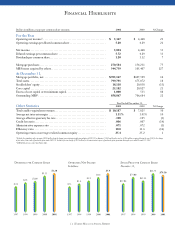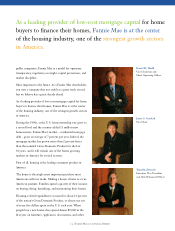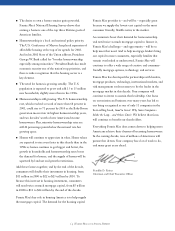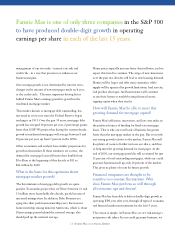Fannie Mae 2001 Annual Report Download - page 10
Download and view the complete annual report
Please find page 10 of the 2001 Fannie Mae annual report below. You can navigate through the pages in the report by either clicking on the pages listed below, or by using the keyword search tool below to find specific information within the annual report.
{ 8} Fannie Mae 2001 Annual Report
Fannie Mae’s efficiency, innovation, and low costs make
us the preferred source of funding for fixed-rate
mortgage loans.
share credit risk with our mortgage insurance partners and,
at times, our lenders. And in our mortgage portfolio, we share
the prepayment risk of fixed-rate mortgages with the buyers
of our callable debt securities and option-based derivatives.
We also have only two principal risks to manage – interest
rate risk and credit risk. We manage those risks on just one
asset, residential mortgages, in just one country. We do
not engage in commercial lending, credit card issuance,
or other types of lending activities. As a consequence, we
can and do focus our full attention on the key risks that
determine mortgage credit and prepayment performance.
Finally, in interest rate risk management we have the
advantage of operating in two of the broadest, deepest,
most transparent, and most liquid markets in the world –
mortgage-backed securities and agency debt. And in
credit risk management, our sole exposure is to an asset
type that is backed by solid collateral – the value on
the homes we finance – and whose quality arguably is
without equal.
How do you manage credit risk?
There are three critical ingredients to our success – accurate
and comprehensive underwriting, active management of
the nonperforming loan process, and the use of third-party
credit enhancements.
The most direct measure of success in credit risk
management is the credit loss rate – the ratio of credit
losses to mortgages held in portfolio or guaranteed as
MBS. Fannie Mae’s credit losses of $81 million in 2001
resulted in a credit loss rate of less than a single basis point.
This is a very small fraction of the credit loss rate of other
financial institutions. With revenues over one hundred
times the size of our credit losses, even a doubling in
Fannie Mae’s credit losses in 2002 – which we do not
expect – would reduce our earnings per share growth by
less than 1 percentage point.
How do you manage interest rate risk?
In our portfolio business, we purchase mortgages and fund
them by selling debt securities that have substantially the
same average lives, or durations, as the loans we buy. The
mortgages we hold in portfolio earn a “spread”– which is
the difference between the average yield on the mortgages
and the cost of the debt that funds those mortgages.
Nearly 90 percent of the mortgages in our portfolio are
long-term fixed-rate. Borrowers can refinance these
mortgages at any time. When interest rates decline and
borrowers refinance their fixed-rate mortgages, the
average yield on our portfolio declines, because higher-
yielding loans pay off and we have to replace them with
lower-yielding loans. To keep this from reducing our
interest spread, we need to be able to lower our average
debt cost in line with the decline in our asset yields.
Callable debt allows us to do that. A majority of the debt
we issue for the portfolio contains a call feature, which
enables us to redeem, or “call”, the debt prior to its stated
maturity at our option. With callable debt, if interest rates
decline, we can redeem our higher-rate debt and replace it
with lower-rate debt. And if interest rates go up, we can
leave the callable debt on our books until its final maturity.























